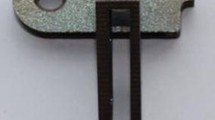Abstract
Foreign object damage (FOD) is one of the common mechanisms in turbine blade failures which reduces high cycle fatigue life and contributes significantly to premature failure. Therefore, this study experimentally simulated FOD on the first stage blade of a gas turbine. Foreign objects with two parameters of object nose shape (spherical, conical, and flat) and impact angle (90° and 45° relative to the blade surface) were impacted on the surface of flat specimens of Udimet-500 at a temperature of 733°C with velocity of 300 m/s (same as working condition of blades). In order to evaluate the impact site morphologies, induced craters were first studied by scanning electron microscopy (SEM). Then samples were sectioned symmetrically, and by using image analysis tool software, the depth of each crater was measured. Finally, based on the results, it was found that maximum and minimum stress concentration factors and induced microcracks, respectively, are regarding to flat projectiles with impact angel of 45° and spherical at impact angle of 90°.











Similar content being viewed by others
References
X. Chen, Foreign object damage on the leading edge of a thin blade. Mech. Mater. 37(4), 447–457 (2005)
S. Zabeen, M. Preuss, P.J. Withers, Residual stresses caused by head-on and 45° foreign object damage for a laser shock peened Ti–6Al–4V alloy aerofoil. Mater. Sci. Eng., A 560, 518–527 (2013)
J.O. Peters, R.O. Ritchie, Influence of foreign-object damage on crack initiation and early crack growth during high-cycle fatigue of Ti–6Al–4V. Eng. Fract. Mech. 67(3), 193–207 (2000)
X. Chen et al., Foreign object damage in a thermal barrier system: mechanisms and simulations. Mater. Sci. Eng., A 352(1–2), 221–231 (2003)
M.W. Crowell et al., Experiments and numerical simulations of single particle foreign object damage-like impacts of thermal barrier coatings. Int. J. Impact Eng 48, 116–124 (2012)
S.M. Marandi, K. Rahmani, M. Tajdari, Foreign object damage on the leading edge of gas turbine blades. Aerosp. Sci. Technol. 33(1), 65–75 (2014)
P. Duó et al., Evaluation and analysis of residual stresses due to foreign object damage. Mech. Mater. 39(3), 199–211 (2007)
C.M. Martinez et al., Effects of ballistic impact damage on fatigue crack initiation in Ti–6Al–4V simulated engine blades. Mater. Sci. Eng., A 325(1–2), 465–477 (2002)
S. Spanrad, J. Tong, Characterization of foreign object damage (FOD) and early fatigue crack growth in laser shock peened Ti–6AL–4V aerofoil specimens. Procedia Eng. 2(1), 1751–1759 (2010)
M.R. Bache, C. Bradshaw, W. Voice, Characterisation of foreign object damage and fatigue strength in titanium based aerofoil alloys. Mater. Sci. Eng., A 354(1–2), 199–206 (2003)
J.J. Ruschau, T. Nicholas, S.R. Thompson, Influence of foreign object damage (FOD) on the fatigue life of simulated Ti–6Al–4V airfoils. Int. J. Impact Eng 25(3), 233–250 (2001)
B. Lin et al., Residual stresses due to foreign object damage in laser-shock peened aerofoils: simulation and measurement. Mech. Mater. 82, 78–90 (2015)
R. Hall et al., Influence of foreign object damage on fatigue crack growth of gas turbine aerofoils under complex loading conditions. Fatigue Fract. Eng. Mater. Struct. 31(5), 386–397 (2008)
B. Lin et al., Fatigue crack growth in laser-shock-peened Ti–6Al–4V aerofoil specimens due to foreign object damage. Int. J. Fatigue 59, 23–33 (2014)
B.L. Boyce et al., The residual stress state due to a spherical hard-body impact. Mech. Mater. 33(8), 441–454 (2001)
B.L. Boyce et al., Mechanical relaxation of localized residual stresses associated with foreign object damage. Mater. Sci. Eng., A 349(1–2), 48–58 (2003)
D. Nowell, P. Duó, I.F. Stewart, Prediction of fatigue performance in gas turbine blades after foreign object damage. Int. J. Fatigue 25(9–11), 963–969 (2003)
P.G. Frankel et al., Residual stress fields after FOD impact on flat and aerofoil-shaped leading edges. Mech. Mater. 55, 130–145 (2012)
Fiat, TTG, TG20 Gas turbine training manual
Fiat, TTG, TG20-Row 1 and 2 rotating blade, Udimet 500 (1985)
R. Viswanathan, Damage Mechanisms and Life Assessment of High Temperature Components (ASM International, 1989)
Author information
Authors and Affiliations
Corresponding author
Rights and permissions
About this article
Cite this article
Farahani, H.K., Ketabchi, M., Zangeneh, S. et al. Characterization of Damage Induced by Impacting Objects in Udimet-500 Alloy. J Fail. Anal. and Preven. 16, 629–634 (2016). https://doi.org/10.1007/s11668-016-0129-7
Received:
Revised:
Published:
Issue Date:
DOI: https://doi.org/10.1007/s11668-016-0129-7




